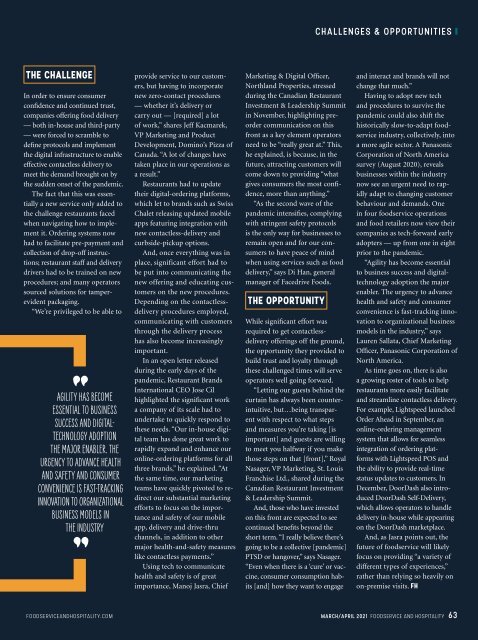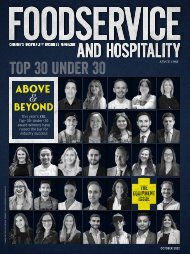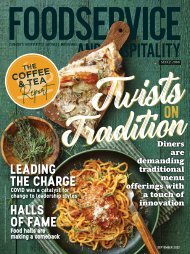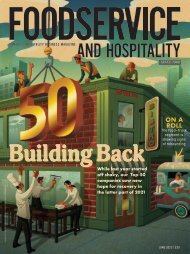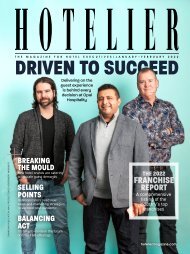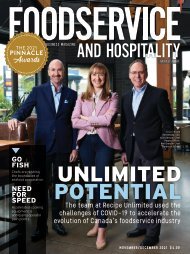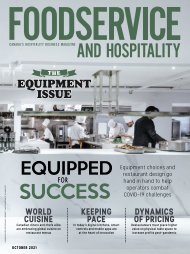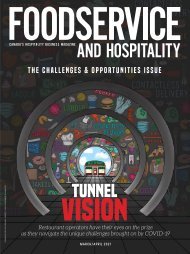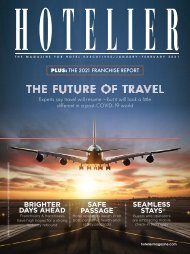March/April (Revised)
You also want an ePaper? Increase the reach of your titles
YUMPU automatically turns print PDFs into web optimized ePapers that Google loves.
CHALLENGES & OPPORTUNITIES<br />
THE CHALLENGE<br />
In order to ensure consumer<br />
confidence and continued trust,<br />
companies offering food delivery<br />
— both in-house and third-party<br />
— were forced to scramble to<br />
define protocols and implement<br />
the digital infrastructure to enable<br />
effective contactless delivery to<br />
meet the demand brought on by<br />
the sudden onset of the pandemic.<br />
The fact that this was essentially<br />
a new service only added to<br />
the challenge restaurants faced<br />
when navigating how to implement<br />
it. Ordering systems now<br />
had to facilitate pre-payment and<br />
collection of drop-off instructions;<br />
restaurant staff and delivery<br />
drivers had to be trained on new<br />
procedures; and many operators<br />
sourced solutions for tamperevident<br />
packaging.<br />
“We’re privileged to be able to<br />
AGILITY HAS BECOME<br />
ESSENTIAL TO BUSINESS<br />
SUCCESS AND DIGITAL-<br />
TECHNOLOGY ADOPTION<br />
THE MAJOR ENABLER. THE<br />
URGENCY TO ADVANCE HEALTH<br />
AND SAFETY AND CONSUMER<br />
CONVENIENCE IS FAST-TRACKING<br />
INNOVATION TO ORGANIZATIONAL<br />
BUSINESS MODELS IN<br />
THE INDUSTRY<br />
provide service to our customers,<br />
but having to incorporate<br />
new zero-contact procedures<br />
— whether it’s delivery or<br />
carry out — [required] a lot<br />
of work,” shares Jeff Kacmarek,<br />
VP Marketing and Product<br />
Development, Domino’s Pizza of<br />
Canada. “A lot of changes have<br />
taken place in our operations as<br />
a result.”<br />
Restaurants had to update<br />
their digital-ordering platforms,<br />
which let to brands such as Swiss<br />
Chalet releasing updated mobile<br />
apps featuring integration with<br />
new contactless-delivery and<br />
curbside-pickup options.<br />
And, once everything was in<br />
place, significant effort had to<br />
be put into communicating the<br />
new offering and educating customers<br />
on the new procedures.<br />
Depending on the contactlessdelivery<br />
procedures employed,<br />
communicating with customers<br />
through the delivery process<br />
has also become increasingly<br />
important.<br />
In an open letter released<br />
during the early days of the<br />
pandemic, Restaurant Brands<br />
International CEO Jose Cil<br />
highlighted the significant work<br />
a company of its scale had to<br />
undertake to quickly respond to<br />
these needs. “Our in-house digital<br />
team has done great work to<br />
rapidly expand and enhance our<br />
online-ordering platforms for all<br />
three brands,” he explained. “At<br />
the same time, our marketing<br />
teams have quickly pivoted to redirect<br />
our substantial marketing<br />
efforts to focus on the importance<br />
and safety of our mobile<br />
app, delivery and drive-thru<br />
channels, in addition to other<br />
major health-and-safety measures<br />
like contactless payments.”<br />
Using tech to communicate<br />
health and safety is of great<br />
importance, Manoj Jasra, Chief<br />
Marketing & Digital Officer,<br />
Northland Properties, stressed<br />
during the Canadian Restaurant<br />
Investment & Leadership Summit<br />
in November, highlighting preorder<br />
communication on this<br />
front as a key element operators<br />
need to be “really great at.” This,<br />
he explained, is because, in the<br />
future, attracting customers will<br />
come down to providing “what<br />
gives consumers the most confidence,<br />
more than anything.”<br />
“As the second wave of the<br />
pandemic intensifies, complying<br />
with stringent safety protocols<br />
is the only way for businesses to<br />
remain open and for our consumers<br />
to have peace of mind<br />
when using services such as food<br />
delivery,” says Di Han, general<br />
manager of Facedrive Foods.<br />
THE OPPORTUNITY<br />
While significant effort was<br />
required to get contactlessdelivery<br />
offerings off the ground,<br />
the opportunity they provided to<br />
build trust and loyalty through<br />
these challenged times will serve<br />
operators well going forward.<br />
“Letting our guests behind the<br />
curtain has always been counterintuitive,<br />
but…being transparent<br />
with respect to what steps<br />
and measures you’re taking [is<br />
important] and guests are willing<br />
to meet you halfway if you make<br />
those steps on that [front],” Royal<br />
Nasager, VP Marketing, St. Louis<br />
Franchise Ltd., shared during the<br />
Canadian Restaurant Investment<br />
& Leadership Summit.<br />
And, those who have invested<br />
on this front are expected to see<br />
continued benefits beyond the<br />
short term. “I really believe there’s<br />
going to be a collective [pandemic]<br />
PTSD or hangover,” says Nasager.<br />
“Even when there is a ‘cure’ or vaccine,<br />
consumer consumption habits<br />
[and] how they want to engage<br />
and interact and brands will not<br />
change that much.”<br />
Having to adopt new tech<br />
and procedures to survive the<br />
pandemic could also shift the<br />
historically slow-to-adapt foodservice<br />
industry, collectively, into<br />
a more agile sector. A Panasonic<br />
Corporation of North America<br />
survey (August 2020), reveals<br />
businesses within the industry<br />
now see an urgent need to rapidly<br />
adapt to changing customer<br />
behaviour and demands. One<br />
in four foodservice operations<br />
and food retailers now view their<br />
companies as tech-forward early<br />
adopters — up from one in eight<br />
prior to the pandemic.<br />
“Agility has become essential<br />
to business success and digitaltechnology<br />
adoption the major<br />
enabler. The urgency to advance<br />
health and safety and consumer<br />
convenience is fast-tracking innovation<br />
to organizational business<br />
models in the industry,” says<br />
Lauren Sallata, Chief Marketing<br />
Officer, Panasonic Corporation of<br />
North America.<br />
As time goes on, there is also<br />
a growing roster of tools to help<br />
restaurants more easily facilitate<br />
and streamline contactless delivery.<br />
For example, Lightspeed launched<br />
Order Ahead in September, an<br />
online-ordering management<br />
system that allows for seamless<br />
integration of ordering platforms<br />
with Lightspeed POS and<br />
the ability to provide real-time<br />
status updates to customers. In<br />
December, DoorDash also introduced<br />
DoorDash Self-Delivery,<br />
which allows operators to handle<br />
delivery in-house while appearing<br />
on the DoorDash marketplace.<br />
And, as Jasra points out, the<br />
future of foodservice will likely<br />
focus on providing “a variety of<br />
different types of experiences,”<br />
rather than relying so heavily on<br />
on-premise visits. FH<br />
FOODSERVICEANDHOSPITALITY.COM<br />
MARCH/APRIL 2021 FOODSERVICE AND HOSPITALITY 63


